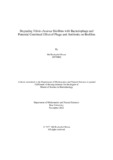Degrading Vibrio cholerae Biofilms with Bacteriophage and potential combined effect of phage and antibiotic on biofilms

View/
Date
2022-11Publisher
Brac UniversityAuthor
Hasan, Md RockybulMetadata
Show full item recordAbstract
Vibrio cholerae is a gram-negative coccobacillus known as the causative agent of cholera- a
gastrointestinal disease endemic to developing and underdeveloped countries, Bangladesh
being one of them. The ability to form biofilms made it very difficult for many broad host range
antibiotics to penetrate through them and destroy them completely. The cells in the biofilm can
persist in a wide range of environmental conditions by remaining metabolically dormant and
able to resuscitate into planktonic cells after getting suitable opportunities which can lead to a
cholera outbreak. Antibiotics have been used to breakdown biofilms, however the attempts
remained unsuccessful in most cases even if the concentration is a few times higher compared
to the planktonic counterpart of the same bacteria. In this study, bacteriophage therapy was
introduced as an alternative to antibiotic treatment for degrading V. cholerae biofilms.
Combined treatment of phage and antibiotic (kanamycin) was performed to check the
effectiveness in degrading biofilms and killing the planktonic bacteria at the same time. In both
cases of single phage and combination treatment there were evidence of decreasing the
biofilm layers of Vibrio strains but not when treated with kanamycin alone. Shiga Toxin
producing E. coli (STEC) was used to screen the phage’s ability to target hosts other than
Vibrio strains, which turned out to be ineffective. There is potential scope to use combined
phage and antibiotic therapy in regulating biofilm formation, but further investigation and risk
evaluation is required
